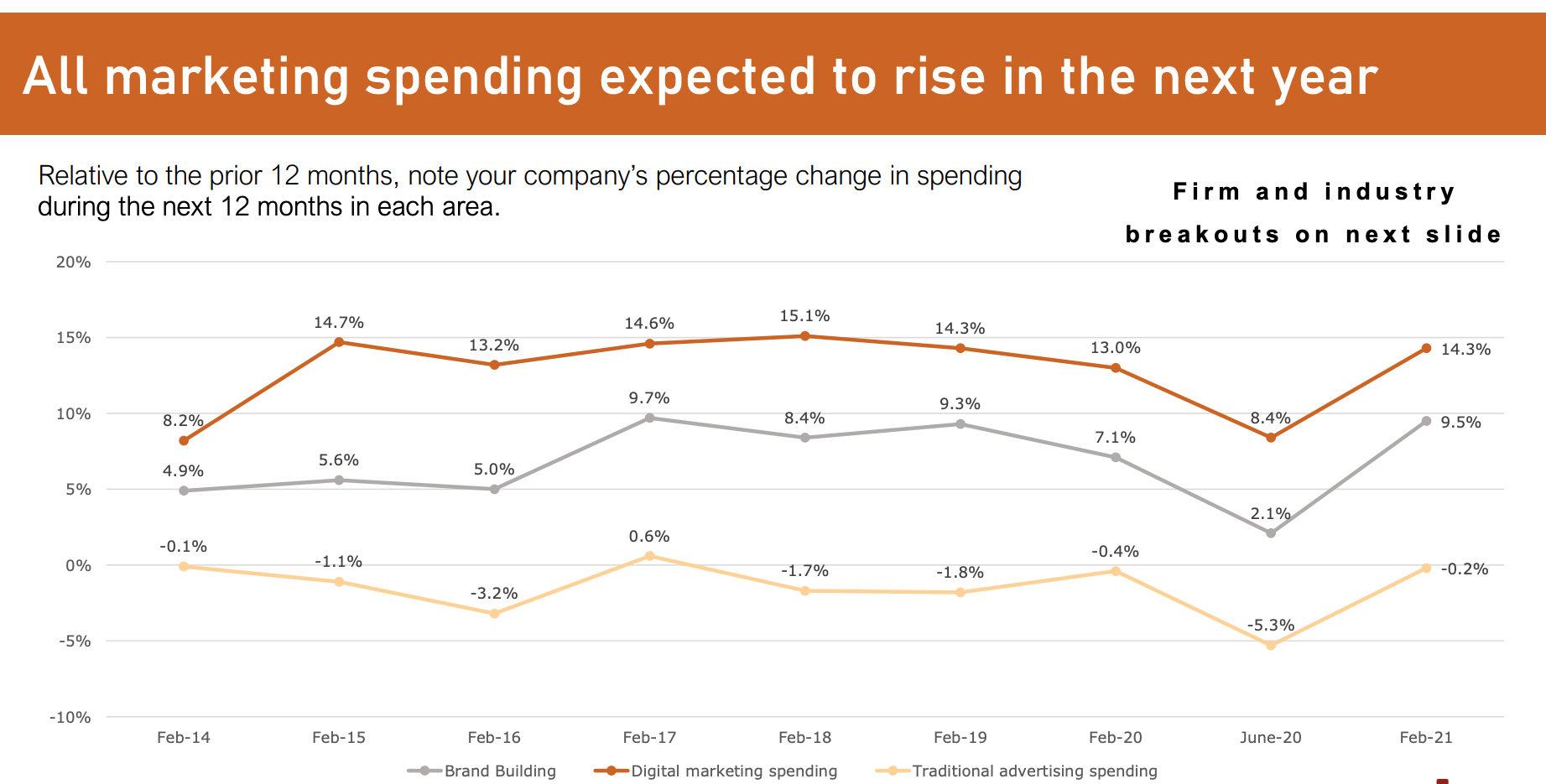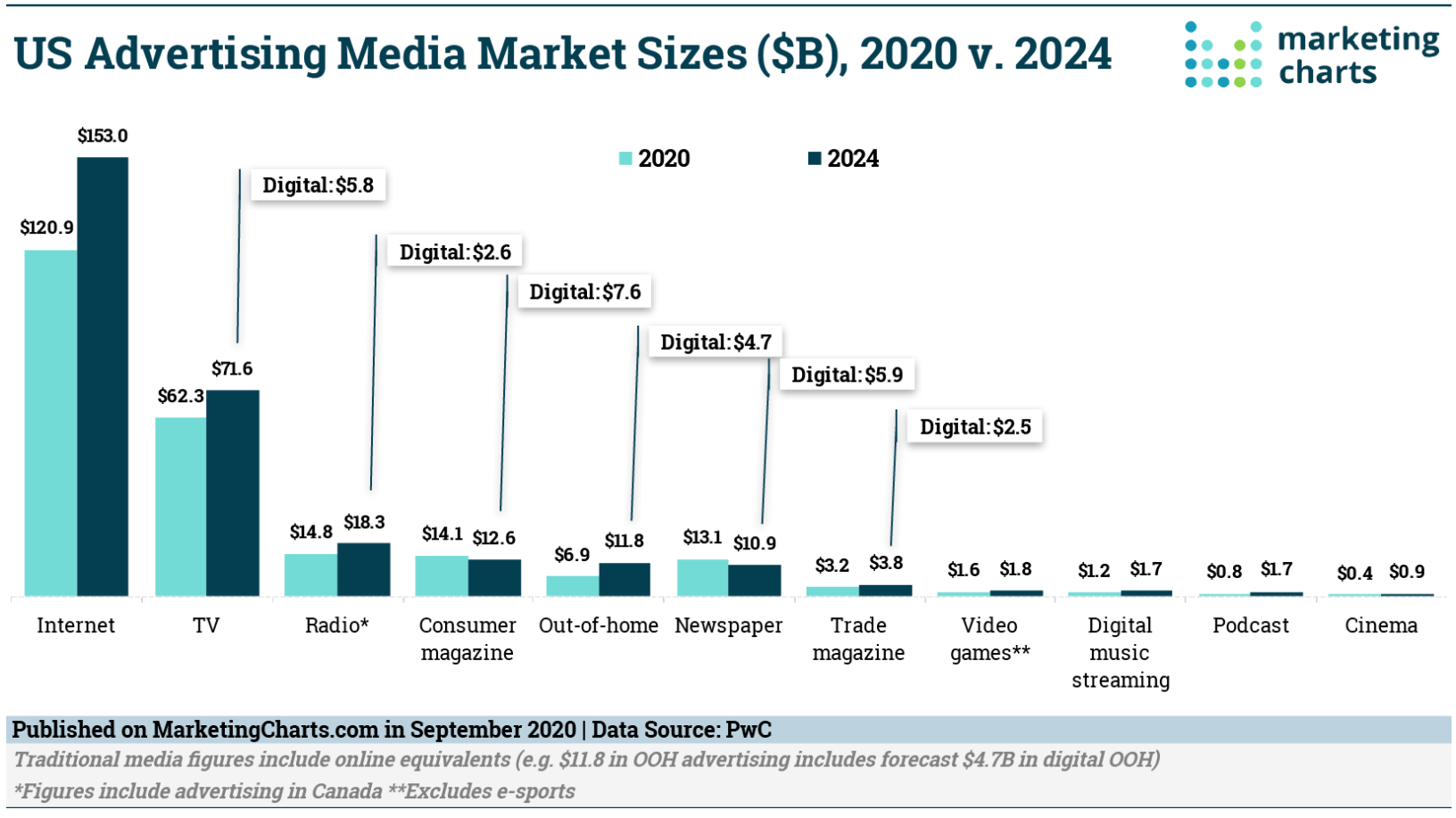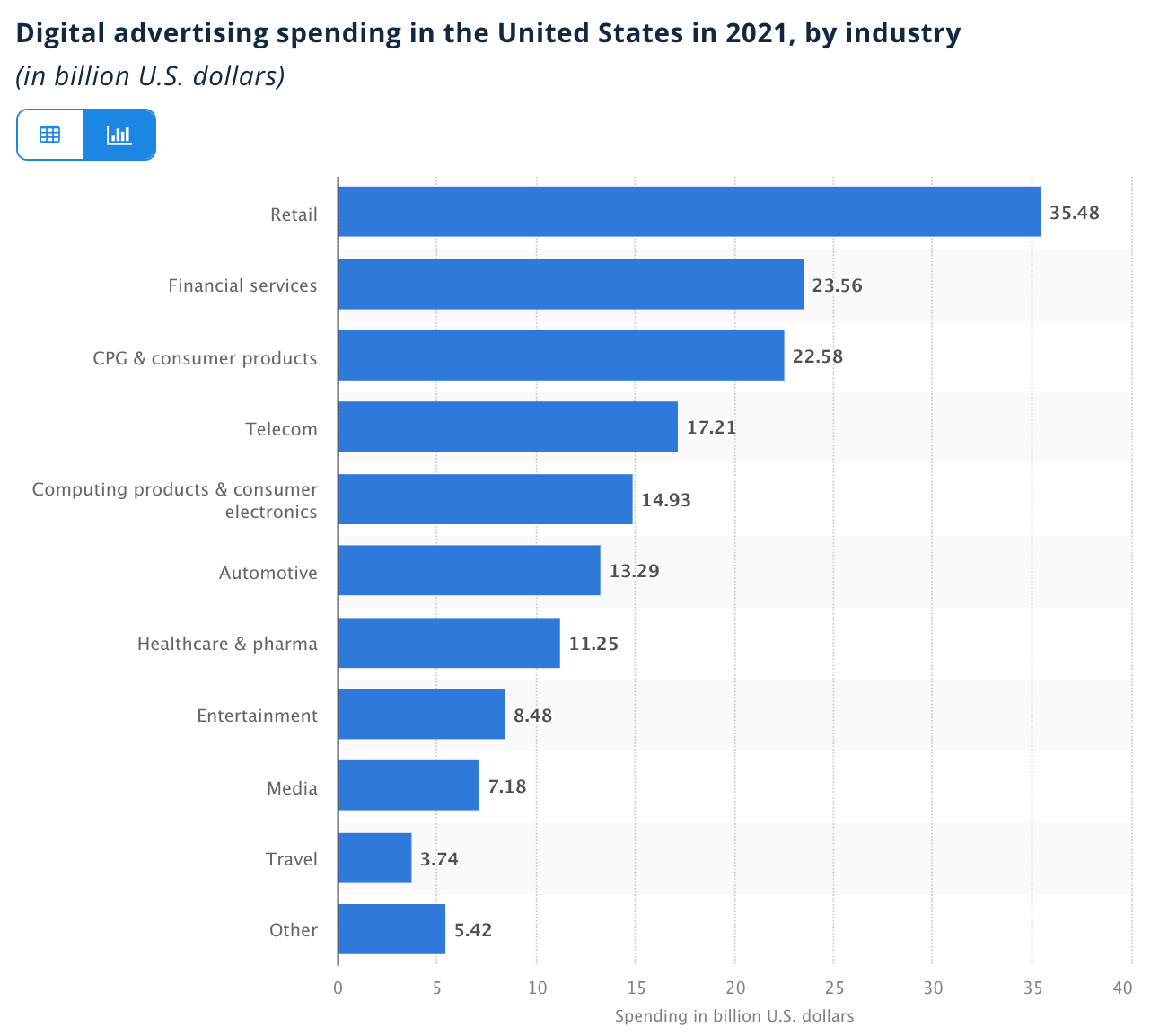Do you want to reach your customers online? Digital marketing enables you to deliver marketing messaging to your ideal customers on a variety of platforms online.
In this guide, we’re going to look at the various aspects of digital marketing and how you can use them to drive qualified traffic to your business.
What Is Digital Marketing?
Digital marketing is the promotion of your business, brand, products, or services to your target audience on desktop, mobile, and smart TV screens. There are several types of digital marketing you can use, all of which we will discuss shortly.
But first, let’s talk about why you should invest in digital marketing.
Why Is Digital Marketing Important?
In the performance section of the CMO Survey, recipients were asked, “To what degree has the use of digital marketing contributed to your company’s performance during last year? (1=not at all, 7=very highly)”
The results?
“Across all sectors and firm sizes, this cannot be overstated with the average reporting a contribution of 5.5 (on a 7-point scale) to their companies’ success.”
Advertisement
Continue Reading Below
The 2021 Gartner Digital Marketing Survey echoed a similar positive response about digital marketing performance, saying that “70% or more said their organizations had met or exceeded a range of 2020 goals, though that positive outlook may reflect performance against goals revised midyear versus set prior to the pandemic.”
How Does Traditional Marketing Compare To Digital Marketing?
Should your business invest in digital marketing over traditional marketing? Traditional marketing includes radio, non-digital billboards, print publications, and offline events.
According to the CMO Survey, digital marketing spend was expected to increase by 14.3% in 2021. Traditional marketing spend, on the other hand, was expected to decrease by 0.2%.
 Screenshot from Cmosurvey.org, September 2021
Screenshot from Cmosurvey.org, September 2021Marketing Charts published data from PwC’s annual Global Entertainment & Media Outlook report.
Advertisement
Continue Reading Below
It shows a breakdown of expected spending changes for digital vs traditional advertising channels from 2020 to 2024.
 Screenshot from Marketingcharts.com, September 2021
Screenshot from Marketingcharts.com, September 2021While some industries may benefit from traditional marketing and advertising, most will benefit from digital marketing.
Statista helps brands in different industries compare their digital advertising spend in 2021.
 Screenshot from Statista.com, September 2021
Screenshot from Statista.com, September 2021What Are The Different Types Of Digital Marketing?
Here are some of the various types of digital marketing businesses and brands use to reach more customers online.
Affiliate Marketing
Affiliate marketing allows businesses (advertisers) to sell their products through third-party publishers (affiliate marketers/affiliates) online.
In most cases, the advertiser provides a personalized referral URL (affiliate link) to their affiliates to use in their website content, blog articles, social media posts, and email messages.
If someone clicks on an affiliate link, the advertiser compensates the affiliate for any leads or sales resulting from that click as per the affiliate agreement.
According to a survey by PepperJam and Forrester, the top-ranked digital marketing channel for customer acquisition in 2019 was affiliate marketing.
This is a winning marketing strategy for businesses that want to transform customers and fans into referral partners who can increase the business’ revenue.
Find out more with the following resources:
Content Marketing
Content marketing allows businesses to communicate marketing messages through a variety of different formats.
Advertisement
Continue Reading Below
Content marketing encompasses blog posts, knowledge base articles, support documentation, white papers, case studies, and similar content resources.
According to Statista, over 60% of B2B and 40% of B2C content marketing budgets were expected to increase in 2021. Further, 69% of companies said they would invest their budget in content creation and production.
A comprehensive content marketing strategy gives your email, search, and social media marketing departments assets to promote.
Learn more in the following resources:
Email Marketing
Email marketing allows businesses to reach people who have consented to receive marketing messages by email. Businesses can collect emails on their website, blog, and social media channels.
Research from Litmus has shown for every dollar spent on email marketing, brands can expect to receive $42 in return.
If you want to convert more of your website traffic, use email marketing to keep people’s attention on your brand until they are ready to make a purchase.
Advertisement
Continue Reading Below
Learn more with the following resources:
Guerilla Marketing
Guerilla marketing allows businesses to gain free public relations for out-of-the-box, viral marketing campaigns that people want to talk about.
Many guerilla marketing campaigns happen offline, like flash mobs and large graffiti art walls.
Since people will talk and share the experience online, it becomes a part of your brand’s digital marketing strategy.
Influencer Marketing
Influencer marketing allows businesses to reach new audiences through popular social media users. Brands campaign with celebrities online to market products via sponsored and paid partnership posts.
A key finding from the State of Influencer Marketing is that “In 2020, sponsored posts received an average of 7,806 impressions (unique views). In 2019, sponsored posts averaged 4,827 impressions. A 57% increase [over 2019].”
Influencer marketing can play a vital role in increasing a brand’s visibility amongst a niche audience.
Advertisement
Continue Reading Below
Learn how with the following resources:
Mobile Marketing
Mobile marketing allows businesses to reach consumers on their smartphones and other mobile devices. Brands can reach mobile users with mobile-targeted advertising as well as SMS/text messaging.
In SimpleTexting’s SMS marketing report, 62% of consumers surveyed said they opted into text message marketing from at least one business within the last year.
If you want to connect with consumers on their mobile devices, learn more about mobile marketing from the following resource.
Advertisement
Continue Reading Below
Podcast Marketing
Podcast marketing allows businesses to reach audiences who listen to podcasts on Spotify, Apple, and other platforms.
Brands can connect with listeners through podcast ads, participating in interviews, or launching a podcast about relevant industry topics.
In 2021, according to Insider Intelligence by eMarketer, advertisers are expected to spend $1.33 billion in podcast advertisements and sponsorships. By 2025, US podcast audiences are expected to grow to 144 million.
In addition to gaining additional brand visibility, your business can use podcasts as assets to acquire links for search engine optimization purposes.
Find out how with the following podcast resources:
Public Relations
Public relations marketing allows businesses to gain visibility for their brand through the media. The goal of PR is to get journalists and influencers talking about your brand, products, and services.
The Global Public Relations Market Report predicts that the global PR market will grow from $88.13 billion in 2020 to $97.13 billion in 2021. The growth is linked to companies recovering from the effects of COVID-19.
Advertisement
Continue Reading Below
When PR marketing is executed effectively, it works to supplement a brand’s social media presence and link-building efforts.
Learn more about PR from the following resources:
Search Engine Marketing
Search engine marketing allows businesses to reach people through search engines like Google, Bing, and Yahoo.
Search engine optimization focuses on rankings in organic search results pages, while pay per click focuses on rankings in paid search results via Google Ads and similar platforms.
According to BrightEdge research, 68% of trackable traffic comes from organic (53%) and paid search (15%).
Organic search rankings, therefore, play a large role in generating qualified traffic for your website.
Learn more with the following resources.
Advertisement
Continue Reading Below
Social Media Marketing
Social media marketing allows businesses to reach their customers on channels like Facebook, Instagram, LinkedIn, Twitter, Pinterest, and TikTok.
We Are Social’s Digital Report for 2021 found that there are 4.2 billion people worldwide who actively use social media. Of those social media users, 27.5% use social media to research products to buy. 44.8% use social media to search for more information about brands.
With such a large portion of the global population on social media, most brands will be able to connect with their target audience through one or more social networking sites. Social media can also help you in your SEO efforts.
Learn how in the following resources:
Streaming TV Marketing
Streaming TV marketing allows businesses to reach consumers while they watch their favorite TV programs online. Thanks to digital streaming, ad platforms can offer specific targeting and results measurement.
Advertisement
Continue Reading Below
According to We Are Social’s Digital Report for 2021, 70% of internet users aged 16 to 64 worldwide stream TV content via the internet.
Ready to reach the cord-cutters who switched from regular TV to digital streaming?
Learn more with the following resources:
Video Marketing
Video marketing allows businesses to reach their audiences with video content. In most cases, this is achieved via YouTube and other video hosting services.
In the State of Video Marketing report by Wyzowl, 78% of video marketers said that video helped increase sales. 83% of video marketers said video increases the average time spent on the site, and 86% said video increased their website traffic.
Use video to fill your content library, promote as a part of your link-building assets, and share as a part of your social media campaigns.
Learn more from the following resources:
Advertisement
Continue Reading Below
Voice Marketing
Voice marketing allows businesses to reach people using voice-enabled services like Alexa (Amazon), Siri (Apple), and Google Assistant.
It also refers to marketing via live or prerecorded audio content on audio-only platforms like Spotify, Clubhouse, and Facebook Live Rooms.
The Narvar Consumer Report found that up to 45% of voice-enabled device owners use voice searches to shop.
Audio-only recordings can be used as additional content in your library, podcasts, and much more. Learn how with the following resources.
Advertisement
Continue Reading Below
There is no perfect formula for digital marketing – your strategy will depend entirely on your unique customers, market space, competitors, products or services, and more.
Hopefully this gives you a good place to start building the digital marketing strategy that works for you!
Featured Image: Bloomicon/Shutterstock
